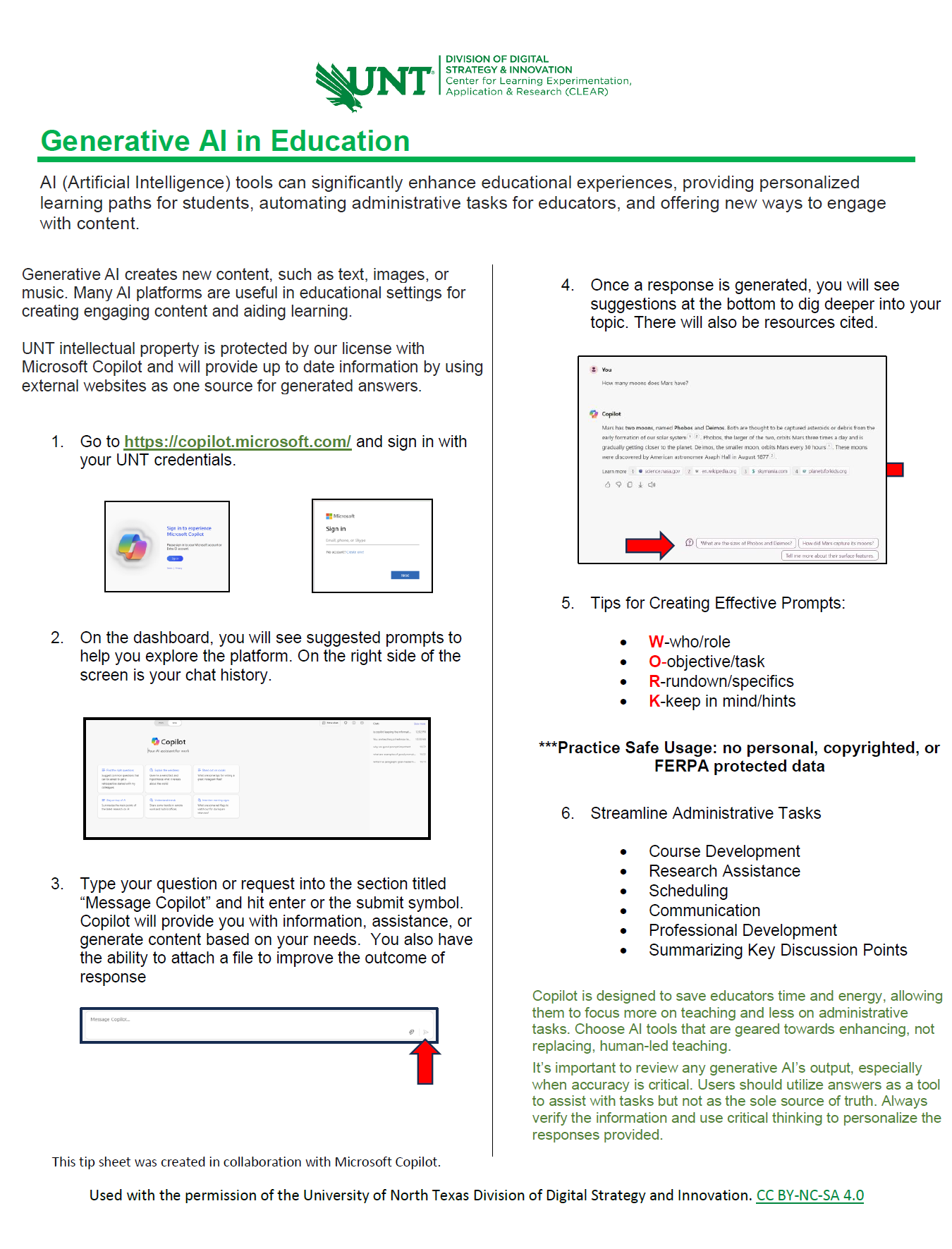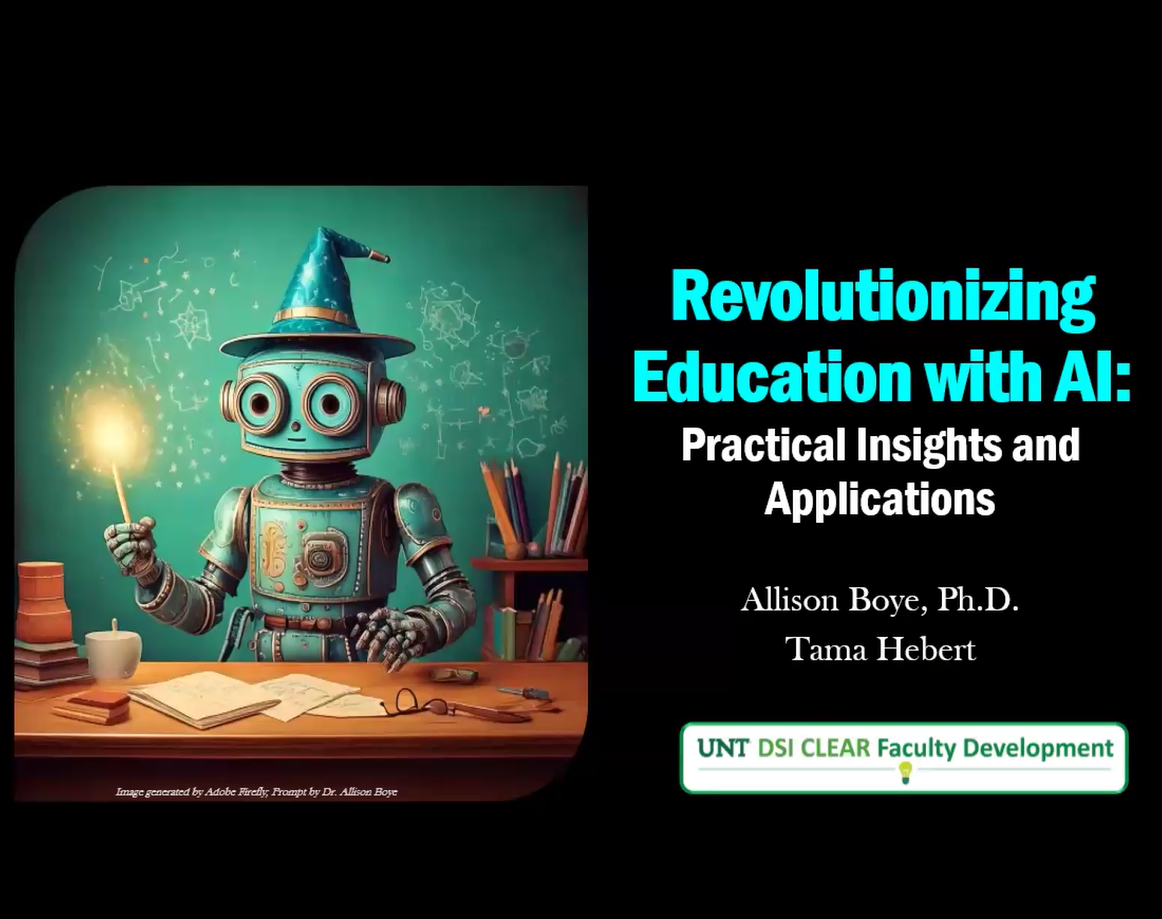- DSI CLEAR
- Teaching Resources
- Theory & Practice
- Methods for Continuous Improvement
- Using AI in the Higher Education Classroom
- Invisible Labor and Faculty Retention Since COVID-19
- Inclusive Discussions
- Inclusive Assessment
- Designing Assessments for Academic Integrity
- Inclusive Instructional Strategies
- Instructor Presence in the Online Classroom
- Tips for Providing Personalized Feedback to Students
- Course Design for Student Retention
- UNT's CLAW 3 Active Learning Classroom Instructional Guide
- UNT Faculty Teaching & Learning Resource Guide
- Growth Mindset in the Higher Education Classroom
- Course Outcomes & Objectives
- Multimedia Course Design for Student Engagement and Retention
- Level Up Learning With Portfolios
- Group Work in Higher Education: Benefits & Practices for Success
- Open Educational Resources & Copyright Essentials for Instructors
- Evaluating OER Resources
- Accessibility Online
- Copyright Guide
- Online Teaching
- UNT Syllabus Template
- Teaching Consultation Request
- Open Educational Resources & Copyright Essentials for Instructors
- Evaluating OER Resources
Using AI in the Higher Education Classroom

The fast-evolving field of AI brings continuous innovation to higher education, with generative AI tools boosting instructor productivity by freeing up time to focus on creative, complex student-focused goals as well as research. Recent updates have expanded users’ ability to customize texts and multimodal content for various audiences, enhancing student engagement and productivity (Fauzi et al., 2023).
The term “Generative AI” refers to computational techniques that generate meaningful content such as text, images, or audio from training data (Feuerriegel, 2023). These models make use of pre-existing information and create outputs that can be both creative and functional and can support us with daily tasks. A tool for creativity and accommodation, Generative AI can also lead to innovation in teaching and learning (Strzelecki, 2023).
Use Cases
Surveys have found that 22 percent of around 3000 instructors use Generative AI (Shaw et al., 2023). Amongst them:
- 43 percent use it to understand how students use the tools.
- 35 percent use it in their teaching.
- 29 percent use it for in-class activities.
- Some also use it to customize complex texts and generate summaries that cater to students’ diverse comprehension skillsets.
According to Langreo (2024), educators have also leveraged Generative AI tools to:
- Create lesson plans
- Provide students with feedback
- Build grading rubrics
- Compose emails
- Write letters of recommendation
- Incorporate AI into assignments to upskill students’ abilities
Teaching Implications for Generative AI
Gen AI can enhance teaching and learning in the higher education classroom and help students stay engaged with the course material (Fuchs, 2023). For example, instructors can design writing assignments in which students actively analyze the tool’s strengths and limitations. By engaging students and exploring the tool together, instructors can introduce students to the importance of ethics and the dangers of plagiarism in the writing
process. That process can help reduce shallow learning and raise awareness about misinformation (Wang et al., 2023). Gen AI can also be used as a powerful writing tool. Generating multiple versions of the same written text can help students evaluate and critique rhetoric and grammar and familiarize themselves with different writing styles (Beck & Levine, 2023).
To discourage plagiarism, graded assignments can include oral presentations, group projects, and hands-on activities that require students to demonstrate their knowledge and skills in a more interactive and engaging way (King, 2023).
Overall, as students show themselves to be enthusiastic about AI tools, it is important for instructors to address the use of these in the classroom (Joyce, 2023). Despite the general enthusiasm, it is also important to note there have been drastic measures taken at some educational institutions due to the fear of the unknown (Lampropoulos, Ferdig, Kaplan-Rakowski, 2023).
Uses
ChatGPT Can Be Used To...
- Teach students critical thinking and writing (Strzelecki, 2023)
- Help developing writers with strategic guidance from teachers (Beck & Levine, 2023)
- Offer students judgment-free assistance when facing a blank page (Beck & Levine, 2023)
- Educate students about ethical concerns and responsible AI use (Okaiyeto et al., 2023)
Instructors Can...
- Adapt their curriculum to include new technological advancements (Wang et al., 2023)
- Provide more inclusive teaching that aligns with a transformative relationship with knowledge (Strzelecki, 2023)
- Shift to a more didactic approach supporting critical thinking, creativity, and real-world application (Fesenmeier, Wöbel, 2023).
- Utilize the tool to differentiate correct from incorrect information by encouraging critical thinking (Joyce, 2023)
- Incorporate ChatGPT in their coursework to prepare graduates who are competitive and adaptable in the evolving job market (Okaiyeto et al., 2023)
ChatGPT Can Help Instructors...
- Write writing prompts (Beck & Levine, 2023)
- Encourage classroom discussion about the benefits and drawbacks of using AI tools (Joyce, 2023)
- Assist students with real-time feedback and personalized learning environments (Wang et al., 2023)
- Utilize AI tools to illustrate these impacts through scenario-based examples, thus shaping students’ mental models of AI tool usage (Wang et al., 2023)
- Enhance productivity (Okaiyeto et al., 2023)
- Manage work-related stress and task accomplishment due to its time-saving features (Bin-Nashwan et al., 2023)
Designing Generative AI into your syllabus
A potential first step toward incorporating AI technology into the higher education classroom is a transparent syllabus. A syllabus that provides guidance on the proper utilization of technology can create a learning environment that is inclusive and supportive of both the student and the instructor. In practice, this might mean creating learning objectives using Bloom’s Taxonomy for working with technologies such as ChatGPT. Syllabus verbiage can emphasize successful learning behaviors and strategies in general.
Instructors are implementing policies in syllabi that range from guiding ChatGPT use in academic work to limiting its use. Overarching guidelines around syllabus language include:
- Setting clear guidelines for the use of ChatGPT on assignments (Tyson, 2023)
- Being honest about the time assignments take
- Offering a choice between AI and non-AI assignments
Microsoft CoPilot
Microsoft’s Copilot is an advanced generative AI chatbot that can be a productive ally and personal assistant to instructors. In addition to improving efficiency, summarizing information, and automating repetitive tasks, instructors can easily draw specific and detailed information from Bing, the search engine, and the Microsoft operating system. Moreover, faculty might find some versions of Copilot compelling as it can instantly generate images, seamlessly animate slides and insert tables and more (Microsoft, 2023). UNT’s license with Copilot also protects faculty members’ intellectual property.
Resources for Instructors
- AI Text Generators Sources: to Stimulate Discussion Among Teachers
- AI Tool List for Educators
- AI Generative Tool Student Survey
- AI in Education Resource Directory
- How to cite ChatGPT
References
Beck, S. W., & Levine, S. R. (2023). Backtalk: ChatGPT: A powerful technology tool for writing instruction. Phi Delta Kappan, 105(1), 66-67.
Epstein, Z., Hertzmann, A., Investigators of Human Creativity, Akten, M., Farid, H., Fjeld, J., ... & Smith, A. (2023). Art and the science of generative AI. Science, 380(6650), 1110-1111.
Fauzi, F., Tuhuteru, L., Sampe, F., Ausat, A. M. A., & Hatta, H. R. (2023). Analysing the role of ChatGPT in improving student productivity in higher education. Journal on Education, 5(4), 14886-14891.
Feuerriegel, S., Hartmann, J., Janiesch, C., & Zschech, P. (2024). Generative ai. Business & Information Systems Engineering, 66(1), 111-126.
Fuchs, K. (2023, May). Exploring the opportunities and challenges of NLP models in higher education: Is Chat GPT a blessing or a curse?. In Frontiers in Education (Vol. 8, p. 1166682). Frontiers.
Gao, R., Merzdorf, H. E., Anwar, S., Hipwell, M. C., & Srinivasa, A. (2023). Automatic assessment of text-based responses in post-secondary education: A systematic review. arXiv preprint arXiv:2308.16151.
Geller, E. S. (2023). If You See Something, Say Something: Cultivating an Actively-Caring-for-People Culture. Behavior and Social Issues, 1-4.
Grymbaum, M. M., & Mac, R. (2023, December 27). New York Times, OpenAI and Microsoft settle lawsuit. The New York Times. https://www.nytimes.com/2023/12/27/business/media/new-york-times-open-ai-microsoft-lawsuit.html
Harmison, B. (2023, April 5). Microsoft Copilot vs. ChatGPT Side By Side. Corsica Technologies. Retrieved from https://www.corsicatech.com/blog/microsoft-copilot-vs-chatgpt/
Helmes, S., & Krieser, J. (2023). Copyrights, Professional Perspective - Copyright Chaos: Legal Implications of Generative AI. Bloomberg Law. Retrieved from https://www.bloomberglaw.com/external/document/XDDQ1PNK000000/copyrights-professional-perspective-copyright-chaos-legal-implic
Jin, Y., Yan, L., Echeverria, V., Gašević, D., & Martinez-Maldonado, R. (2024). Generative AI in Higher Education: A Global Perspective of Institutional Adoption Policies and Guidelines. arXiv preprint arXiv:2405.11800.
Joyce, A. (2023). Embracing AI: Using Cat-GPT to Encourage Classroom Discussion. College Teaching, 1-3.
King, M.R., ChatGPT. A Conversation on Artificial Intelligence, Chatbots, and Plagiarism in Higher Education. Cel. Mol. Bioeng. 16, 1–2 (2023). https://doi.org/10.1007/s12195-022-00754-8
Langreo, L. (2024, April). Should Teachers Disclose When They Use AI? Education Week. Retrieved June 13, 2024, from https://www.edweek.org/technology/should-teachers-disclose-when-they-use-ai/2024/04
Lampropoulos, G., Ferdig, R. E., & Kaplan-Rakowski, R. (2023). A Social Media Data Analysis of General and Educational Use of ChatGPT: Understanding Emotional Educators. Available at SSRN 4468181.
Lee, D., Arnold, M., Srivastava, A., Plastow, K., Strelan, P., Ploeckl, F., Lekkas, D., & Palmer, E. (2024). The impact of generative AI on higher education learning and teaching: A study of educators’ perspectives. Computers and Education: Artificial Intelligence, 6, 100221.
McKendrick, J. (2022, December 21). Who ultimately owns content generated by ChatGPT and other AI platforms? Forbes. Retrieved July 9, 2024, from https://www.forbes.com/sites/joemckendrick/2022/12/21/who-ultimately-owns-content-generated-by-chatgpt-and-other-ai-platforms/?sh=308a9e985423
Microsoft. (2023, March 16). Introducing Microsoft 365 Copilot: Your copilot for work. Microsoft Blog. Retrieved July 9, 2024, from https://blogs.microsoft.com/blog/2023/03/16/introducing-microsoft-365-copilot-your-copilot-for-work/ Microsoft. (n.d.). Copilot prompts. Copilot. https://copilot.cloud.microsoft/en-US/prompts?ocid=copilot_akams_copilotlab
Montgomery, B. (2023, November 6). OpenAI offers to pay for ChatGPT customers’ copyright lawsuits. The Guardian. https://www.theguardian.com/technology/2023/nov/06/openai-chatgpt-customers-copyright-lawsuits
Mowreader, A. (2024, February 6). How college professors are using generative AI to teach. Inside Higher Ed. https://www.insidehighered.com/news/student-success/academic-life/2024/02/06/how-college-professors-are-using-generative-ai-teach
Okaiyeto, S. A., Bai, J., & Xiao, H. (2023). Generative AI in education: To embrace it or not?. International Journal of Agricultural and Biological Engineering, 16(3), 285-286.
Patrizio, A. (2024). Microsoft Copilot. TechTarget. Retrieved June 30, 2024, from https://www.techtarget.com/whatis/definition/Microsoft-Copilot
Rodríguez, J. M. R., Montoya, M. S. R., Fernández, M. B., & Lara, F. L. (2023). Use of ChatGPT at university as a tool for complex thinking: Students' perceived usefulness. NAER: Journal of New Approaches in Educational Research, 12(2), 323-339.
Samuelson, P. (2023). Generative AI meets copyright. Science, 381(6654), 158-161.
Shaw, C., Yuan, L., Brennan, D., Martin, S., Janson, N., Fox, K., & Bryant, G. (2023). Generative AI in Higher Education: Fall 2023 Update of Time for Class Study. Technical Report. Tyton Partners, Boston, MA. Accessed July 18, 2024 from https://tytonpartners.com/app/uploads/2023/10/GenAI-IN-HIGHER-EDUCATION-FALL-2023-UPDATE-TIME-FOR-CLASS-STUDY.pdf.
Smith, B., & Nowbar, H. (2023, September 7). AI, copyright, and our commitment to the law: Responding to legal concerns about Copilot. Microsoft on the Issues. https://blogs.microsoft.com/on-the-issues/2023/09/07/copilot-copyright-commitment-ai-legal-concerns/
Strzelecki, A. (2023). To use or not to use ChatGPT in higher education? A study of students’ acceptance and use of technology. Interactive Learning Environments, 1-14.
Susarla, A. (2024, March 22). Generative AI could leave users holding the bag for copyright violations. The Conversation. Retrieved July 9, 2024, from https://theconversation.com/generative-ai-could-leave-users-holding-the-bag-for-copyright-violations-225760
Tyson, J. (2023). Shortcomings of ChatGPT. Journal of Chemical Education, 100(8), 3098-3101.
Wang, T., Díaz, D. V., Brown, C., & Chen, Y. Exploring the Role of AI Assistants in Computer Science Education: Methods, Implications, and Instructor Perspectives
Zewe, A. (2023, November 9). Explained: Generative AI. MIT News. Retrieved July 9, 2024, from https://news.mit.edu/2023/explained-generative-ai-1109

